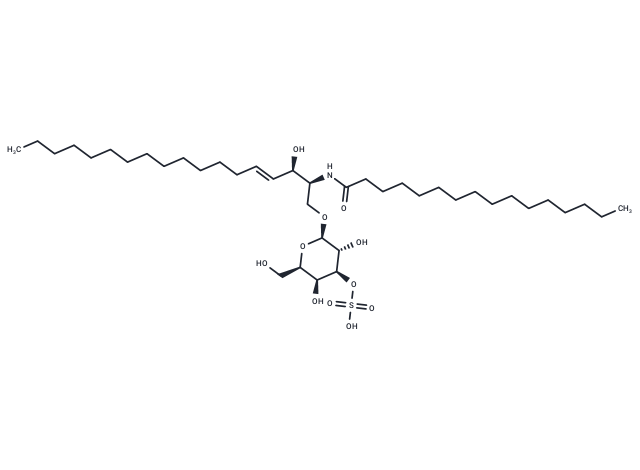- Remove All
 Your shopping cart is currently empty
Your shopping cart is currently empty
C16 3'-sulfo Galactosylceramide (d18:1/16:0)
C16 3'-sulfo Galactosylceramide (d18:1/16:0) is a sulfated glycolipid.C16 3'-sulfo Galactosylceramide (d18:1/16:0) is a relatively abundant sulfide found in porcine brain and plasma that decreases throughout development in mice.C16 3'-sulfo Galactosylceramide is a relatively abundant sulfide found in porcine brain and plasma that decreases throughout development in mice.C16 3'-sulfo Galactosylceramide is a relatively abundant sulfide found in porcine brain and plasma that decreases throughout development in mice. C16 3'-sulfo Galactosylceramide (d18:1/16:0) inhibits retinal ganglion cell growth in vitro.C16 3'-sulfo Galactosylceramide (d18:1/16:0) has been used as an internal standard for quantifying C16 3'-sulfo Galactosylceramide (d18:1/16:0) in rat cerebellum and white matter isolated from patients with multiple sclerosis. reference for sulphides.

C16 3'-sulfo Galactosylceramide (d18:1/16:0)
| Pack Size | Price | Availability | Quantity |
|---|---|---|---|
| 1 mg | $1,760 | Backorder |
Product Introduction
| Description | C16 3'-sulfo Galactosylceramide (d18:1/16:0) is a sulfated glycolipid.C16 3'-sulfo Galactosylceramide (d18:1/16:0) is a relatively abundant sulfide found in porcine brain and plasma that decreases throughout development in mice.C16 3'-sulfo Galactosylceramide is a relatively abundant sulfide found in porcine brain and plasma that decreases throughout development in mice.C16 3'-sulfo Galactosylceramide is a relatively abundant sulfide found in porcine brain and plasma that decreases throughout development in mice. C16 3'-sulfo Galactosylceramide (d18:1/16:0) inhibits retinal ganglion cell growth in vitro.C16 3'-sulfo Galactosylceramide (d18:1/16:0) has been used as an internal standard for quantifying C16 3'-sulfo Galactosylceramide (d18:1/16:0) in rat cerebellum and white matter isolated from patients with multiple sclerosis. reference for sulphides. |
| In vitro | C16:0 sulfatide (20 nmol/ml) inhibits glucose-stimulated insulin secretion by reducing the sensitivity of the K(ATP) channels to ATP. (The half-maximal inhibitory concentration is 10.3 and 36.7 micromol/l in the absence and presence of C16:0 sulfatide, respectively.) [1]
C16:0 sulfatide (20 nmol/ml for 30 min) increased whole-cell K(ATP) currents at intermediate glucose levels and reduced the ability of glucose to induce membrane depolarization, reduced electrical activity, and increased the cytoplasmic free Ca2+ concentration. Recordings of cell capacitance revealed that C16:0 sulfatide increased Ca2+-induced exocytosis by 215%. This correlated with a stimulation of insulin secretion by C16:0 sulfatide in intact rat islets exposed to diazoxide and high K+.[1] C16:0 sulfatide (20 nmol/l for 24 h) did not modulate glucagon secretion from intact rat islets.[1] |
| In vivo | C16:0 sulfatide (1 µmol/kg,1 mL ; Zucker rats) resulted in significantly elevated glucose-stimulated insulin secretion (60-80% increase, p < 0.05), without significant changes in glucose tolerance. The treatment was associated with an ameliorated first-phase insulin response (3-4-fold, p = 0.009, 0.016) and a 60% increase of pancreatic sulfatide content (p = 0.001), possible by an uptake of C16:0 sulfatide. The fasting hyperinsulinaemia and blood glucose levels were unchanged.[2] |
| Alias | C16 3'-sulfo Galactosylceramide (d18:1/16:0) |
| Molecular Weight | 780.1 |
| Formula | C40H77NO11S |
| Cas No. | 89771-78-8 |
| Smiles | O(C[C@@H]([C@@H](/C=C/CCCCCCCCCCCCC)O)NC(CCCCCCCCCCCCCCC)=O)[C@H]1[C@H](O)[C@@H](OS(=O)(=O)O)[C@@H](O)[C@@H](CO)O1 |
| Storage | store at low temperature | Powder: -20°C for 3 years | In solvent: -80°C for 1 year | Shipping with blue ice. |
| Solubility Information | Chloroform:Methanol (2:1): Soluble |
Sci Citations
Calculator
In Vivo Formulation Calculator (Clear solution)
Dose Conversion
Tech Support
Keywords

Copyright © 2015-2025 TargetMol Chemicals Inc. All Rights Reserved.




